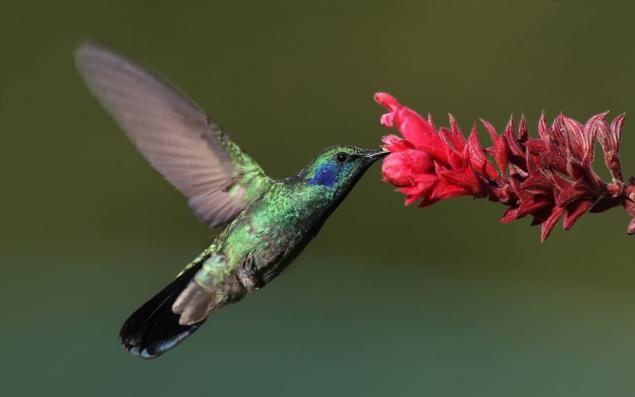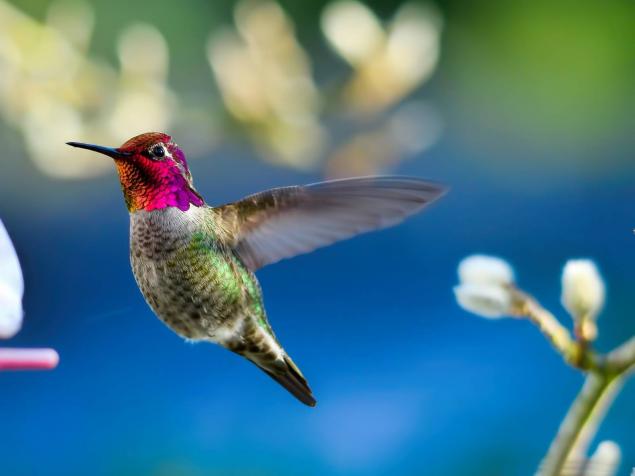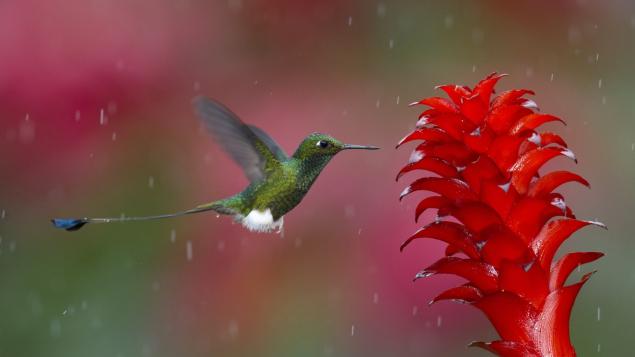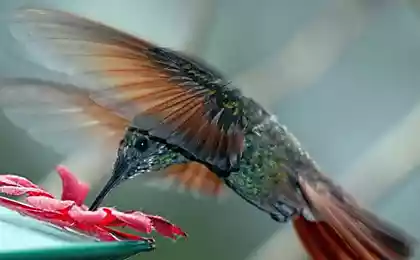798
Physics in the world of animals: a Hummingbird and its flight

Hummingbird — small-sized birds that live in North and South America. There are 330 species of hummingbirds, and the vast majority are brightly colored birds of very small size. Hummingbirds weigh only a few grams. The maximum size of a single species of Hummingbird is almost equal to the size of an ordinary Starling. The smallest Hummingbird weighs 2 grams, the length of her body only a few centimeters.
Hummingbirds are remarkable not only for size. The fact that these birds are masters of flight of a high class. They can fly in almost any direction, hover in the air, perform vertical takeoff and landing. Hang on place and a few other birds, but hummingbirds are superior to all other types of staying in one place for a long time and without apparent effort.
During the flight on the spot" Kolibri should be written out of the wings eight. Thanks to it the bird rests in the air in a vertical position. The speed of the flapping of Hummingbird's wings are huge — about 50-80 strokes per second. But this is not the limit. Caring for the female of the male of one species of Hummingbird makes more than 200 strokes per second. Acceleration to maximum speed and instant stop these birds occur almost instantly, in just a few seconds. The speed of a small bird up to 50 km/h that is really a lot for such a small creature.
According to Douglas Warrick [Douglas Warrick of Oregon state University (Oregon State University), hummingbirds use flight style, which is intermediate between the style of the style birds and insects. During the flight, these animals produce around 25% of the lift from the movement of the wings up and 75% of the down move. In insects the situation is somewhat different from the movements of the wings up and down the body receives about 50% of the lift. In most birds the body receives a lifting force mainly from the movements of the wings down.

Christopher Clark [Christopher Clark] from the University of California with high-speed camera recorded the moment of occurrence of the Hummingbird at the peak. The calculations showed that hummingbirds develop a speed of about 400 hulls per second. It is more than that included in the afterburner of a jet fighter or space Shuttle that enters the Earth's atmosphere. Despite the speed, the Hummingbird and the brake almost instantaneously, as has already been mentioned. So quickly to stop the movement are very few organisms that can fly.
Hummingbird exceed in the art of flight, the vast majority of birds. And the body structure, the structure of the wings different from other birds. In order to get the opportunity so quick to flap their wings, hummingbirds should have a short and straight bones of the shoulder and forearm. The bones of the wings — strong and lightweight because they are hollow. The structure of the wing is very stiff due to the fact that some joints just don't move.
Shoulder joints are flexible. Because of this, they can move in any direction. They can also rotate approximately 180 degrees. Plus, a Hummingbird can change the angle of the wing to change the trajectory of the movement. It is capable of a very small number of bird species. But bones should be and powerful muscles. A Hummingbird mass of wing muscles make up about 40% of the entire mass of the body.
To provide oxygen to muscles during work and need more oxygen. Its Hummingbird get due to well-developed respiratory system, which includes 9 air bags. They are light with a single system. During movement the muscles push out the air from these sacs, making the lungs receive an additional portion of oxygen.
To provide the entire body with oxygen — not an easy task. But to cope with it a lot of heart, which occupies about half the bird's body. It pumps the blood, delivering oxygen to all tissues and organs of the Hummingbird. The frequency of cardiac rhythm in the case of Hummingbird — 500 beats per minute at rest. During the flight the bird pulse is accelerated up to 1200 beats per minute. Breathing is also very fast — up to 600 cycles of inhale-exhale per minute.

For such an active job you need and nutrients. Most Hummingbird receives sufficient energy from nectar is a very nutritious substance, which almost instantly digestive system of a bird. During the day a number of small species of hummingbirds feed on nectar, consume two times more food than its weight. Practically all the energy expended on the flight. In the active state, the body of the Hummingbird is heated to approximately 42 °C. at Night the temperature drops to 15-22°C. Very few warm-blooded animals are able to survive with such a sudden change in body temperature.
To extract the necessary amount of food hummingbirds use their long beak, is able to penetrate deep into the calyx. Some species of hummingbirds come out even more, piercing beak, the base of the flower, if can not reach the nectar in the usual way. For the extraction of nectar use and a long tongue having a special form. This form helps the nectar to stay in the language at the time, when a Hummingbird decided to eat.

Nectar is captured by the language and the shape language goes right into the throat. To provide your body with sufficient energy, several types of hummingbirds must eat often — every 10-20 minutes. Flying birds under the rain is necessary for their survival. If hummingbirds could not fly in the rain, this would put at risk the survival of some species.
Surprise Hummingbird in that it is able to fly very long distances. For example, ruby-throated Hummingbird for the winter they fly from Canada to Mexico and Panama. The distance of the flight is 5000 miles. The average flight speed of about 50 kilometers per hour. Not all large birds are able to withstand such a long and exhausting flight, not to mention the birds.
Scientists say that Hummingbird is just made for flying. It is hardly an exaggeration to say that hummingbirds are the best fliers in the world.
Source: geektimes.ru/post/280534/























